Infantry Equipment, Australian Pattern (Leather) - Haversacks and Packs
Haversacks
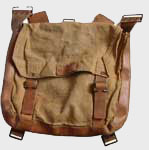
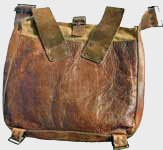 The Infantry Equipment, Australian Pattern (Leather) Haversack is a copy of the second issue Pattern 1908 Haversack with leather chapes and straps. The dimensions of the Haversack are the same as those of the Pattern 1908 Haversacks, approximately 9-inches tall by 11-inches wide by 2-inches deep. These have a vertical 1-inch chape on the rear, and a horizontal 1-inch web loop sewn on the flap. These connections fit to the
matching (first issue) variation of the Water bottle carrier, similar to the W.E. Patt. '08 second issue, that could be carried on this Haversack. Australian KWRT Graham Tweeddale reports that NAA file Test of infantry Equipment Leather, Series MP 367/1 Control Symbol 402/7/13, contains a reference to two types of Water bottle carriers: "the 'new pattern” with the fixed back strap & the 'old pattern' which the water bottle was prone to fall out of". The reference to the fixed back strap on the "new pattern" suggests that the original version has the sliding rear strap of the Patt. '08 second issue Carrier. This early Australian Pattern Haversack has a canvas body with the rear face made of leather. Presumably there were leather and web ones also. From the Grant Napier Collection, photographs © Grant Napier 2008.
The Infantry Equipment, Australian Pattern (Leather) Haversack is a copy of the second issue Pattern 1908 Haversack with leather chapes and straps. The dimensions of the Haversack are the same as those of the Pattern 1908 Haversacks, approximately 9-inches tall by 11-inches wide by 2-inches deep. These have a vertical 1-inch chape on the rear, and a horizontal 1-inch web loop sewn on the flap. These connections fit to the
matching (first issue) variation of the Water bottle carrier, similar to the W.E. Patt. '08 second issue, that could be carried on this Haversack. Australian KWRT Graham Tweeddale reports that NAA file Test of infantry Equipment Leather, Series MP 367/1 Control Symbol 402/7/13, contains a reference to two types of Water bottle carriers: "the 'new pattern” with the fixed back strap & the 'old pattern' which the water bottle was prone to fall out of". The reference to the fixed back strap on the "new pattern" suggests that the original version has the sliding rear strap of the Patt. '08 second issue Carrier. This early Australian Pattern Haversack has a canvas body with the rear face made of leather. Presumably there were leather and web ones also. From the Grant Napier Collection, photographs © Grant Napier 2008.
 The inner flap of the Haversack shown above. This Haversack is maker marked "C.G.H.F." (Commonwealth Government Harness Factory) and dated 1915.
The inner flap of the Haversack shown above. This Haversack is maker marked "C.G.H.F." (Commonwealth Government Harness Factory) and dated 1915.
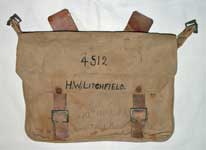
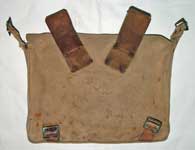
 The example shown here is typical of the most common variation of the Australian Pattern Haversack. It copies the design of the third issue Patt. '08 Haversack, but the dimensions differ slightly: approximately 8 /2-inches tall by 12-inches wide by 2-inches deep. It has a web body and leather chapes and straps and tongueless Twigg buckles. Based on our current knowledge of the Australian Pattern Equipment, Karkee Web believes that Haversacks with web bodies, like this one, probably preceded the canvas bodied ones. It is maker marked "C.G.H.F." and dated 1915. From the Graham Tweeddale Collection, photographs © Graham Tweeddale 2009.
The example shown here is typical of the most common variation of the Australian Pattern Haversack. It copies the design of the third issue Patt. '08 Haversack, but the dimensions differ slightly: approximately 8 /2-inches tall by 12-inches wide by 2-inches deep. It has a web body and leather chapes and straps and tongueless Twigg buckles. Based on our current knowledge of the Australian Pattern Equipment, Karkee Web believes that Haversacks with web bodies, like this one, probably preceded the canvas bodied ones. It is maker marked "C.G.H.F." and dated 1915. From the Graham Tweeddale Collection, photographs © Graham Tweeddale 2009.
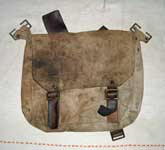
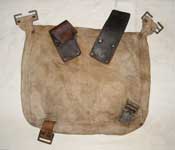 Another example of the most common variation of the Australian Pattern Haversack., but this one has a canvas body and leather chapes and straps. It has the plain Twigg buckles of first issue Australian Pattern. Otherwise identical Haversacks with second issue tongued buckles are also known. This Haversack is maker marked "C.G.H.F." and dated 1915 (or possibly 1916, the date is not clear).
Another example of the most common variation of the Australian Pattern Haversack., but this one has a canvas body and leather chapes and straps. It has the plain Twigg buckles of first issue Australian Pattern. Otherwise identical Haversacks with second issue tongued buckles are also known. This Haversack is maker marked "C.G.H.F." and dated 1915 (or possibly 1916, the date is not clear).
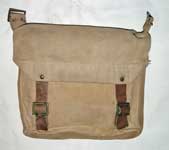
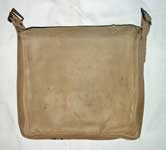 A very interesting Haversack that appears to be an Australian Pattern variation of the Haversack, Other Services. The Other Services Haversack was introduced in 1911 "for units not wearing 1908 web equipment". Its List of Changes entry (L. of C. 15459, dated 20th February 1911) also suggests that it was intended for mounted service, stating in part "all tabs, buckles, &c., not required for mounted troops have been removed." Current opinion at Karkee Web is that this Haversack is also probably intended for mounted service. It has a web body and leather chapes and straps with tongueless Twigg buckles. Just as the Haversack, O.S., is smaller than the Patt. '08 version, this one is smaller than the normal Australian Pattern Haversack, measuring 10”x 8 1/2”x 2”. This example is maker marked "C.G.H.F." and dated 1915. From the Graham Tweeddale Collection, photographs © Graham Tweeddale 2009.
A very interesting Haversack that appears to be an Australian Pattern variation of the Haversack, Other Services. The Other Services Haversack was introduced in 1911 "for units not wearing 1908 web equipment". Its List of Changes entry (L. of C. 15459, dated 20th February 1911) also suggests that it was intended for mounted service, stating in part "all tabs, buckles, &c., not required for mounted troops have been removed." Current opinion at Karkee Web is that this Haversack is also probably intended for mounted service. It has a web body and leather chapes and straps with tongueless Twigg buckles. Just as the Haversack, O.S., is smaller than the Patt. '08 version, this one is smaller than the normal Australian Pattern Haversack, measuring 10”x 8 1/2”x 2”. This example is maker marked "C.G.H.F." and dated 1915. From the Graham Tweeddale Collection, photographs © Graham Tweeddale 2009.
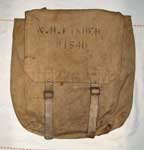
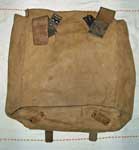 The Infantry Equipment, Australian Pattern (Leather) Pack, like the Haversack, is a copy of the Pattern 1908 one with leather chapes and straps. The dimensions of the Pack are the same as those of the Pattern 1908 Pack, approximately 15-inches tall, 13-inches wide, and 4 1/2-inches deep. This one has a heavy canvas body, but again, like the Haversack, examples are known with web bodies. It is maker marked "C.G.H.F." and date 1917.
The Infantry Equipment, Australian Pattern (Leather) Pack, like the Haversack, is a copy of the Pattern 1908 one with leather chapes and straps. The dimensions of the Pack are the same as those of the Pattern 1908 Pack, approximately 15-inches tall, 13-inches wide, and 4 1/2-inches deep. This one has a heavy canvas body, but again, like the Haversack, examples are known with web bodies. It is maker marked "C.G.H.F." and date 1917.
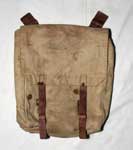
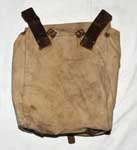
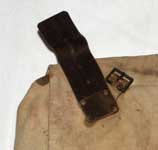
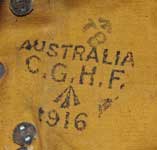 Another example of the Pack. Like the one above, it has a canvas body. Note the rear detail showing the tongued Twigg buckles. Maker marked "C.G.H.F." and dated 1916, this Pack is from the Merlijn van Eijk Collection. Photographs © Merlijn van Eijk 2010.
Another example of the Pack. Like the one above, it has a canvas body. Note the rear detail showing the tongued Twigg buckles. Maker marked "C.G.H.F." and dated 1916, this Pack is from the Merlijn van Eijk Collection. Photographs © Merlijn van Eijk 2010.